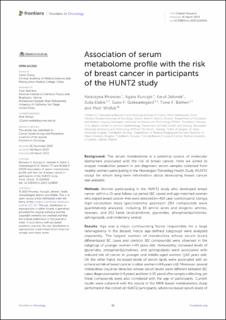| dc.description.abstract | Background: The serum metabolome is a potential source of molecular biomarkers associated with the risk of breast cancer. Here we aimed to analyze metabolites present in pre-diagnostic serum samples collected from healthy women participating in the Norwegian Trøndelag Health Study (HUNT2 study) for whom long-term information about developing breast cancer was available.
Methods: Women participating in the HUNT2 study who developed breast cancer within a 15-year follow-up period (BC cases) and age-matched women who stayed breast cancer-free were selected (n=453 case-control pairs). Using a high-resolution mass spectrometry approach 284 compounds were quantitatively analyzed, including 30 amino acids and biogenic amines, hexoses, and 253 lipids (acylcarnitines, glycerides, phosphatidylcholines, sphingolipids, and cholesteryl esters).
Results: Age was a major confounding factor responsible for a large heterogeneity in the dataset, hence age-defined subgroups were analyzed separately. The largest number of metabolites whose serum levels differentiated BC cases and controls (82 compounds) were observed in the subgroup of younger women (<45 years old). Noteworthy, increased levels of glycerides, phosphatidylcholines, and sphingolipids were associated with reduced risk of cancer in younger and middle-aged women (≤64 years old). On the other hand, increased levels of serum lipids were associated with an enhanced risk of breast cancer in older women (>64 years old). Moreover, several metabolites could be detected whose serum levels were different between BC cases diagnosed earlier (<5 years) and later (>10 years) after sample collecting, yet these compounds were also correlated with the age of participants. Current results were coherent with the results of the NMR-based metabolomics study performed in the cohort of HUNT2 participants, where increased serum levels of VLDL subfractions were associated with reduced risk of breast cancer in premenopausal women.
Conclusions: Changes in metabolite levels detected in pre-diagnostic serum samples, which reflected an impaired lipid and amino acid metabolism, were associated with long-term risk of breast cancer in an age-dependent manner. | en_US |

